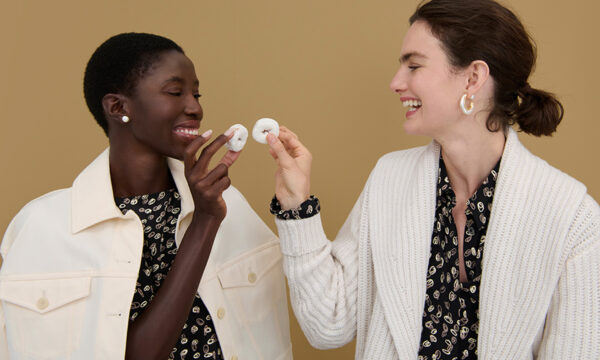
The Gwynne dress, Axam turtleneck, Milo jeans, and Ponza earrings.
I Tried Five Self-Care Methods So You Don’t Have To
Self-care is in the air. Here’s my honest review of five popular stress-busting techniques.
Ahh, back-to-school season. Along with the new, blank notebooks and freshly sharpened pencils comes a wave of self-reflection and goal-setting. And as I gear up for fall and the year ahead, I’m attempting to take a habit of self-care along with me. But as much as we hear about “wellness” and “self-care,” which of these methods actually works? Below, I tried five self-care techniques to see what worked for me.
Want more M Dash?
Sign up for our weekly newsletter.
Thank you!
1. Acupuncture
My first thought when going in for acupuncture was: will it hurt? While I don’t have a debilitating fear of needles, the thought of becoming a human pincushion was not the most, shall we say, relaxing. Still, I’ve heard friends and acquaintances sing the praises of acupuncture for everything from fertility struggles to pain relief to stress management, and it seemed worth a shot.
At both places I tried, the practitioner started the session with a discussion of what I hoped to get out of my session. At one place, the intake process felt almost like therapy, with a lot of questions about my emotional state, while the other place I went felt more medical and formulaic. After the discussion, you lie fully clothed on a padded table while the acupuncturist places needles at various strategic points on your body. The needles are very thin, so they didn’t hurt, but occasionally, one would prompt a zap-like, almost vibrating feeling. The needles remain in place for about 15 minutes while you lie still and relax. A practical note: acupuncture isn’t safe for everyone, such as those with bleeding disorders, so check with your doctor before proceeding.
It might have been the time spent lying still with no distractions, but after each session I tried, I left feeling calm and relaxed—a sensation that persisted throughout the day. However, the effects didn’t feel especially long-lasting, and my acupuncturist let me know that I would need to attend regularly scheduled sessions to feel the biggest effects.

The Sierra shacket, Charli top, Curie pants, Rowan flats, and Beatriz earrings.
2. Manifesting
Manifesting can take a variety of forms—vision boards, journaling, affirmations—but common to all of them is the practice of focusing on a goal, then shifting your thoughts in order to achieve it. Though it was first popularized in Rhonda Byrne’s The Secret, it’s taken on a life of its own: Google searches for “manifesting” increased 669% during a four-month period in 2020.
Anxious to see what all the fuss was about, I armed myself with a journal and got to work. I started with some affirmations, writing “I am” statements and finishing the sentence with the end result of my goal. For example, if your goal is to have $1M in your bank account and be rich, you might write, “I am rich. I have one million dollars.”
The exercise quickly felt…extremely awkward. My brain fought back with a heavy dose of realism. But while I struggled with pretending I had already achieved my goals, it was helpful to put pen to paper and officially record my goals in the first place. The more specific I got, the more I was able to see the specific actions I’d need to take in order to achieve them. So while manifesting wasn’t particularly useful for me, having my goals—and a roadmap toward them—outlined on paper made it easier to take steps toward achieving them.
3. Gratitude Practice
Everyone from Oprah Winfrey to Arianna Huffington has a daily gratitude practice and sings the praises of its effect on their lives. It’s simple enough: name three things you’re grateful for at the same time every day (most people choose either first thing in the morning or before they go to bed at night). As the theory goes, recognizing what you already have helps you focus on the good in your life, rather than wanting the things you don’t have. The things you’re grateful for don’t have to be grand—they can be as small as a particularly good latte. The important thing is to choose unique things each day, rather than repeating the same things over and over.
After starting this practice, I quickly found myself noticing small pleasures throughout my day even more—I’d flag things to myself to remember later in the day for my practice. It also helped me shift to more positive thinking. The toughest part was consistency: I’ve started and stopped this process what feels like ten times. And sometimes, after an especially busy day, I had little patience for the extra step before going to bed. One night, I wrote “sleep!” then promptly shut my notebook. However, there’s a reason so many successful people rely on this technique—if you can keep it up, it works.

The Steffi jacket, Elizabeth top, and Claressa earrings.
4. Sound Bath
What could be more relaxing than “bathing” in the vibrations and sounds of singing bowls and instruments? Bonus: It didn’t require me to do anything but lie on the floor with a cushion. I could do this.
For a sound bath, you usually lie on a mat or cushion in a darkened room while a practitioner uses various instruments (like Tibetan singing bowls, cymbals, bells, and didgeridoos) to create a soothing, vibrating soundtrack with overlapping sounds. At first, the vibrations felt a bit intense, but before long, I floated into a peaceful, meditative state. It was, frankly, pretty tough not to fall asleep.
When it was over, I felt extremely calm and blissful, and I definitely slept well that night. Do I think it had a lasting effect? Not at all. But I can see it being a great way to unwind after a long or particularly stressful week. Plus, it let me use the word “didgeridoo” in a sentence, and that opportunity doesn’t come along very often.
5. Reiki
Reiki is the Japanese practice of energy healing. I must admit that I brought a heavy dose of skepticism to the experience; if my first question about acupuncture was whether it would hurt, my first question about reiki was whether it would actually do anything.
During the session, you lie on a massage table—in my case, surrounded by crystals and Tibetan singing bowls. The practitioner scanned my body, identifying “blocked” areas and getting my energy to flow better. She occasionally used gentle touch, placing her hands in specific energy locations, but she also held her hands just above my body at a short distance for much of the time. Throughout the session, I felt calm and relaxed, and at some points, I felt a swirling sensation (energy, is that you?).
Afterward, the reiki master revealed what she had seen in each of my chakras, or focal points in my body. Even though she had no background information about me, she somehow had me down to a T, from my personality to my struggles and mental blocks. After she relayed the messages she saw in each chakra, she gave me advice on how to balance what she saw. Many of her suggestions came back to one underlying theme: Play more. Get wild. Have fun. Let go. Did I need a reiki master to tell me these things? Maybe not. But I’m all for any form of self-care that prescribes fun as the solution to my problems. I felt relaxed and refreshed that day, and I’ve referred occasionally to the notes she gave me about each chakra as a good reminder.
Was my life irrevocably changed from any of these practices? Probably not. But I can see myself dipping into some of them during stressful bouts or combining them with time-tested, mainstream stress reduction methods, like nutrition and exercise. Sometimes, taking an hour for yourself—no matter what you’re doing—is just enough to improve your outlook.

The Nicky jacket, Darcy top, and Sima earrings.










